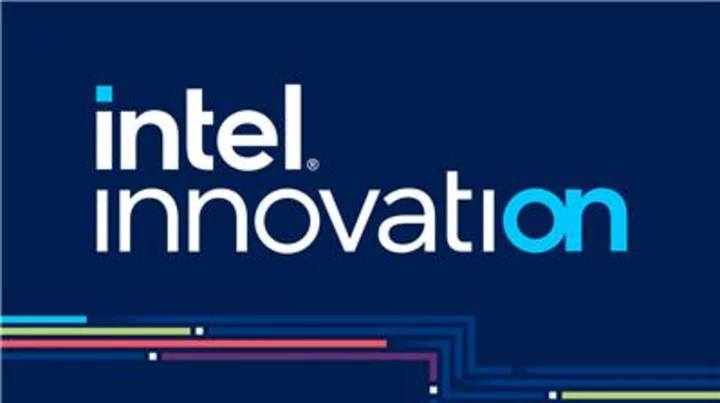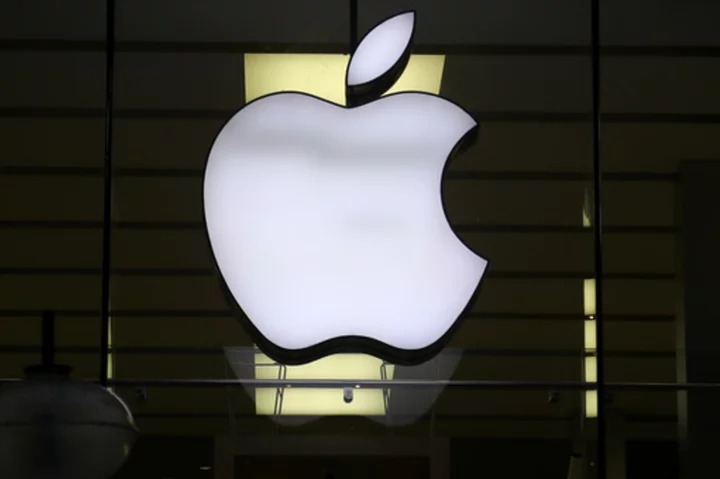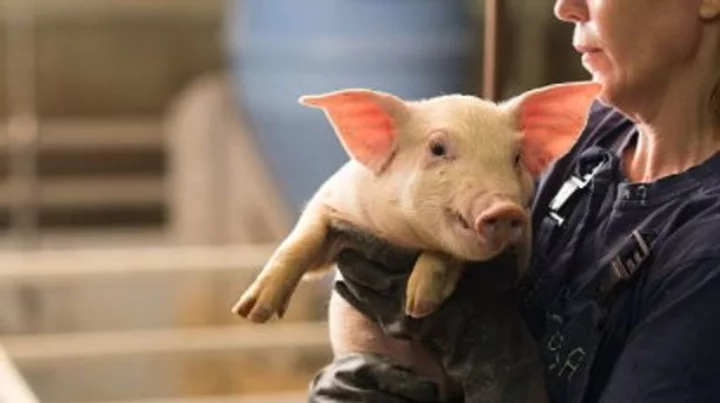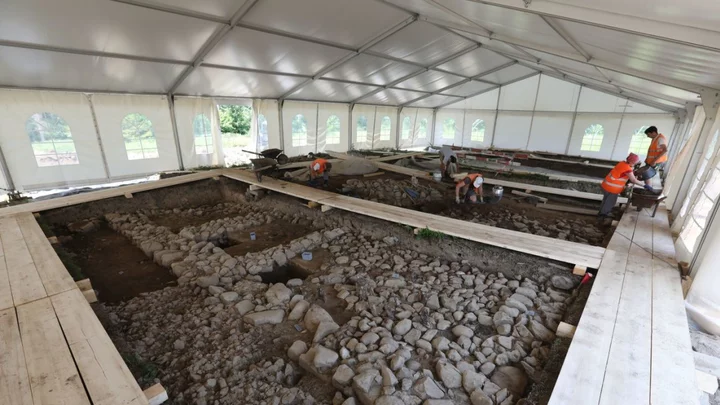
Media Alert: Join Intel Innovation on Sept. 19-20
SANTA CLARA, Calif.--(BUSINESS WIRE)--Sep 8, 2023--
2023-09-08 21:22

Thermo Fisher Scientific Recognized by R&D 100 Awards for Innovations in Science and Technology
WALTHAM, Mass.--(BUSINESS WIRE)--Sep 8, 2023--
2023-09-08 20:59

Legible Secures Worldwide Rights to Stan Lee's Workforce in Landmark Deal With Kartoon Studios
VANCOUVER, British Columbia--(BUSINESS WIRE)--Sep 8, 2023--
2023-09-08 20:59

Apple loses about $200 billion in market capitalization on reports of iPhone restrictions in China
Apple has lost around $200 billion in market capitalization over several days as tensions between the U.S. and China rise, with several media outlets reporting this week that the iPhone maker is being singled out by Beijing
2023-09-08 20:55

Teens Are Entering High School Reading at a Third Grade Level
LOS ANGELES--(BUSINESS WIRE)--Sep 8, 2023--
2023-09-08 20:45

China's Huawei launches Mate 60 Pro+ smartphone for presale
BEIJING China's Huawei Technologies on Friday started presales for its Mate 60 Pro+ smartphone, adding a new version
2023-09-08 20:26

iOS update: iPhone users urged to install new software immediately after powerful security hole found
iPhone users have been urged to download a new update immediately. The update was pushed out by Apple to iPhones and iPads after a major security vulnerability was found in the devices. Patching up that hole with the new software update should keep those devices safe. But without it, attackers could break into an iPhone and spy on its user. The security issue was found by researchers at the University of Toronto’s Citizen Lab. They said the problem was being “actively exploited” by hackers, and that all users should update immediately. They were doing so by delivering commercial software called Pegasus, which is made and sold by Israeli company the NSO Group. That software is expensive and targeted, and has primarily been used on specific activists, journalists and politcians, who are likely to know if they are at particular risk of an attack. The latest attack was used on the iPhone of a member of staff at a US civil society organisation with international offices, Citizen Lab said. It named the new exploit BLASTPASS and said that it did not even require users to click anything on their device. The NSO Group and Apple have in recent years been engaged in a long-running fight to find and fix security flaws that could allow for the delivery of that software. Recent iPhone updates brought a new “Lockdown Mode” that places extra restrictions on the device in an attempt to close up potential security flaws. That includes not downloading images that could include spyware, for instance – which is how attackers deliver the hack in this most recent scare. Downloading the new update is simple. It is done through the Settings app on iPhones and iPads, by clicking the “general” and then “software update” options – that will check for any new updates, and offer the option to download it. Phones may eventually automatically install the new operating system, which could mean that no download shows up in that screen. Users can check if they have already updated to the new, patched operating system by clicking the “about” option in the general settings, and looking whether they have the newest iOS 16.6.1. Similar updates are available for Macs and Apple Watches, and are installed in much the same way. Citizen Lab also advised that anyone “who may face increased risk because of who they are or what they do” should switch on Lockdown Mode. Apple confirmed that would block the new attack, researchers said. Read More Apple is dropping leather from iPhone cases and Watch bands, report claims Apple is about to make a huge change to the iPhone that it never wanted to do Here’s when you will actually be able to get the new iPhone
2023-09-08 20:22

Nvidia, India's Reliance strike AI partnership for apps, language models
By Munsif Vengattil and Dhwani Pandya BENGALURU (Reuters) -U.S. chip firm Nvidia and telecom-to-retail giant Reliance on Friday announced an
2023-09-08 20:20

Scientists grow human kidneys inside a pig for the first time
Scientists have grown human kidneys in pigs, for the very first time. Researchers at the Guangzhou Institutes of Biomedicine and Health, Chinese Academy of Sciences and Wuyi University created human-pig chimeric embryos containing a combination of human and pig cells. When they transferred into 13 surrogate pig mothers, they developed kidneys that contained mostly human cells at a rate of 50 to 60 per cent, giving hope for potential transplants in the future. “Rat organs have been produced in mice, and mouse organs have been produced in rats, but previous attempts to grow human organs in pigs have not succeeded,” said the senior author Liangxue Lai. “Our approach improves the integration of human cells into recipient tissues and allows us to grow human organs in pigs.” The kidneys were not entirely human as they included vasculature and nerves made mostly from pig cells, meaning they could not be used for transplantation in their current form, but it is still a pretty impressive step. And apart from the kidneys, the embryos were dominated by pig cells, with very few human cells in the brain or central nervous system. Making brains using human and pig cells is very controversial for ethical reasons, so there are tight regulations for this kind of research. Meanwhile, pig cells tend to outcompete human cells during development, so previous experiments have created embryos that are almost entirely pig. The latest work, published in Cell Stem Cell, overcame this by genetically engineering a single-cell pig embryo so that it lacked two genes needed for kidney development. This created a gap within the embryo that could be filled by human cells. “We found that if you create a niche in the pig embryo, then the human cells naturally go into these spaces,” said Prof Zhen Dai of Guangzhou Institutes of Biomedicine and Health, another senior author. The scientists said that being able to incubate a fully human kidney inside a pig would be likely to take many years. “We would probably need to engineer the pigs in a much more complex way and that also brings some additional challenges,” said Miguel Esteban, also of the Guangzhou institute and a senior author. A central challenge would be to allow human nerves and vasculature to develop within the target organ without nerve cells developing in the central nervous system that could lead to a humanised brain. “Even theoretically it’s not clear how you’d do that,” said Ilic. Sign up to our free Indy100 weekly newsletter Have your say in our news democracy. Click the upvote icon at the top of the page to help raise this article through the indy100 rankings.
2023-09-08 19:52

Ant Group Unveils its Financial Large Language Model and Two New Applications
SHANGHAI--(BUSINESS WIRE)--Sep 8, 2023--
2023-09-08 18:45

Human embryo created without using sperm or eggs
Scientists in Israel have created a model of a human embryo from stem cells, without using sperm, eggs or a womb. A team at Israel's Weizmann Institute of Science made the model, which resembles an embryo at day 14, when it acquires internal structures but before it lays down the foundations for body organs, and the work was published in the journal Nature. But the scientists involved said it would take a long time yet to create an embryo from scratch. Team leader Jacob Hanna said the team took stem cells derived from adult human skin cells, as well as others cultured in the lab, then reverted the cells to an early state.They then manipulated them to make a model of an embryo, rather than an actual or synthetic one. "The question is, when does an embryo model become considered an embryo? When that happens, we know the regulations. At the moment we are really, really far off from that point," Hanna said. However, they said the work could open the door to new ways to test the effect of drugs on pregnancies, better understand miscarriages and genetic diseases, and maybe grow transplant tissues and organs. "They are not identical. There are differences from human embryos, but still, this is the first time, if you open an atlas or a textbook, you can say - yeah I can really see the similarity between them," said Hanna. "In about 1 percent of the aggregates we can see that the cells start differentiating correctly, migrating and sorting themselves into the correct structure, and the farthest we could get is day 14 in human embryo development," he said. Their next goal, Hanna said, is to advance to day 21 and also reach a threshold of a 50 per cent success rate. Magdalena Żernicka-Goetz, a professor of development and stem cells at the University of Cambridge, said the study joins six other similar human embryo-like models published from teams around the world this year, including from her lab. "None of these models fully recapitulate natural human development but each adds to ways in which many aspects of human development can now be studied experimentally," she said. Sign up to our free Indy100 weekly newsletter Have your say in our news democracy. Click the upvote icon at the top of the page to help raise this article through the indy100 rankings.
2023-09-08 18:27

Discovery in Swiss Alps called an 'archaeological sensation'
The remains of 2,000-year-old Roman walls have been discovered by archaeologist in Switzerland in the foothills of the Alps. During the excavation of a gravel pit in Cham in the canton, or state, of Aug in central Switzerland, the walls, which once protected a Roman building complex, were found. Other pieces have also been unearthed by archaeologists, include a plaster wall, iron nails, and gold fragments. As well as items such as bowls, millstones for grinding, glassware, and crockery and ceramic jugs known as amphorae. In a statement form the Office for the Preservation of Monuments and Archeology, the findings were labelled an "archaeological sensation" for the region and could shed light on Roman activity in central Switzerland. Gishan Schaeren, head of the Department of Prehistory and Protohistoric Archaeology said in the statement: "Roman buildings of similar dimensions were last excavated in Cham-Heiligkreuz almost 100 years ago. We were also amazed that the top bricks were even visible above ground." The walls extend over an area of at least 5,300 square feet (500 square metres). Although it's unclear how Romans used the site, including whether it was a "villa with a view or a temple building," said professor of archaeology of the Roman provinces at the University of Bern Christa Ebnöther. The team said that findings of Roman tableware known as terra sigillata - which means "sealed earth" in Latin - were found, suggesting elite people were at the site. The amphorae, which typically held liquids such as wine, olive oil and fish sauce, are evidence that Romans in the region traded with those in the Mediterranean. Archaeologists also found several copper and bronze coins, including a silver denarius minted by Julius Caesar from the first century B.C. The discovery of the Roman walls is not the first ancient find in the area. Previously, archaeologists had found remains of a middle Bronze Age settlement, burials from the late Bronze Age, and a number of coins form the era of the Celts. Sign up to our free Indy100 weekly newsletter Have your say in our news democracy. Click the upvote icon at the top of the page to help raise this article through the indy100 rankings.
2023-09-08 17:26
You Might Like...

Scientists make 'shocking' discovery on Saturn's moon that could reveal signs of life

Crowd overwhelms New York City's Union Square, tosses chairs, climbs on vehicles

GameCrate Relaunches

Hipcamp Partners With Campflare To Help Campers Snag Reservations at Sold-Out Public Campgrounds

Elon Musk says he's found a new CEO for Twitter

Putting Generative AI to Work: Smartsheet Announces New AI Features that Unlock the Power of the Smartsheet Platform

HyperX Sponsors Arizona State University Study to Help Discover Breakthrough Player Performance Predictions Using Biometrics

Paysend and Visa Strengthen Their Strategic Collaboration to Help Transform Global Money Movement
